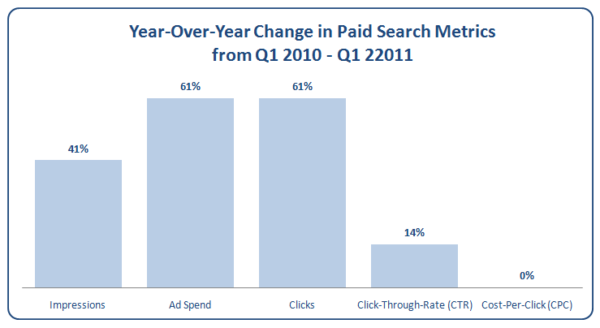Keeping Pace As Competition In Paid Search Heats Up
Back in December 2010, I was relatively convinced that click prices were going to continue increasing in 2011, but Marin Software recently released a study of large scale paid search programs that suggests otherwise. The Paid Search Quarterly Benchmarking Report showed that although average cost per click (CPC) has increased since December 2010, it hasn’t […]
Back in December 2010, I was relatively convinced that click prices were going to continue increasing in 2011, but Marin Software recently released a study of large scale paid search programs that suggests otherwise.
The Paid Search Quarterly Benchmarking Report showed that although average cost per click (CPC) has increased since December 2010, it hasn’t changed year-over-year. However, the underlying trend is the same trend we’ve seen for the past couple of years: advertisers continue to migrate dollars from offline to online advertising, driving spend on paid search higher.
The first couple months of 2011 revealed some interesting paid search marketing trends, including increased paid search volume and click-through rates for large advertisers. But, as mentioned, click prices remained stable over year-over-year.
A review of the first quarter of this year in comparison to the same period in 2010, shows that large scale advertisers ramped up their paid search ad spend by an average of 61% year-over–year. At the same time, paid search ads served jumped, providing 41%* more impressions this year versus last.
As paid search impressions and spend increased, large-scale paid search marketers have also increased efficiency. By better optimizing their growing campaigns, marketers in the index have increased click-through-rates 14% since 2011, while holding overall costs-per-click stable.
While it’s possible that CPCs rose for some terms, overall improvements in quality appeared to have helped large advertisers keep a lid on average keyword prices.
Have you seen similar trends in your campaigns? More importantly, given the trend, have you taken the right steps to structure your campaigns for profitable growth?
Here are a couple tips for “industrial strength” paid search marketers to pay attention to as they continue their quest for increased volume and efficiency.
- Use Technology to Drive Scale – As the paid search landscape becomes more competitive, the ability to grow paid search campaigns while maintaining a consistent ROI will become increasingly challenging. Whether you choose to develop your own tools, or use a third party platform, make sure that you are leveraging technology to drive efficiency. Remember that saving a couple of hours a week through automated reporting or bidding provides time savings that you can reallocate towards launching new campaigns, refining keyword sets, or optimizing creative.
- Benchmark Growth Against the Competition – Are you growing your campaigns fast enough? To find out, start by comparing your spend growth against the industry, or better yet your competition. Your search engine account teams likely have some basic information that you can use as a starting point. To get a more precise picture of how you stack up, you can leverage industry benchmarking reports available free from a variety of SEM vendors, agencies, and research organizations. Finally, the best benchmarking tools allow you to make comparisons to competitors directly. Tools like Hitwise or Comscore are a great source for this data, but typically require a subscription.
- Make Sure Your Ad Copy Stands Out – With increasing volume, you can also expect increased competition, making your creative more important than ever. Make sure you are periodically performing an analysis of your ads in comparison to competitors. Being thoughtful about how your calls to action compare in the competitive landscape will not only help you to grow your programs, but will help to maintain or increase efficiency.
- Add Negatives – Whenever you scale programs by adding new campaigns, it’s important to remember to optimize your negative keywords. Adding negatives will help you shape your traffic and maintain return-on-investment ratios. I suggest reviewing the raw queries from the past couple months and adding appropriate negatives to ensure you’re aren’t paying for non-converting clicks.
Increased search volume and click-through rates are good news. If online activity is a leading indicator of the economy then hopefully everyone’s revenue will be up in 2011. I look forward to seeing if these early 2011 trends continue.
*Editors Postscript: An updated chart has been posted and a change made to the copy here, to resolve the error with juxtaposed numbers (as noted in comments below).
Contributing authors are invited to create content for Search Engine Land and are chosen for their expertise and contribution to the search community. Our contributors work under the oversight of the editorial staff and contributions are checked for quality and relevance to our readers. The opinions they express are their own.
Related stories
New on Search Engine Land
